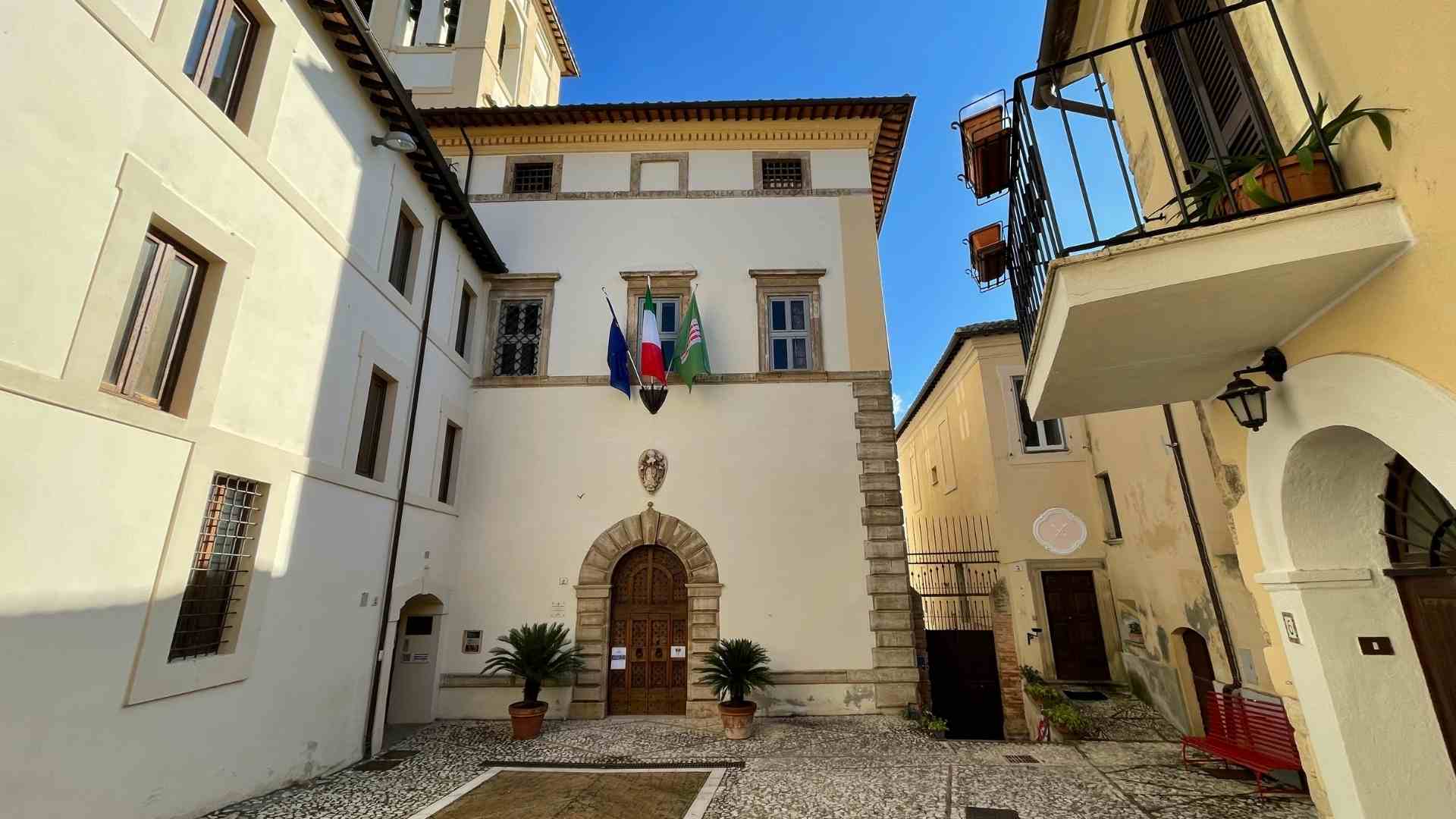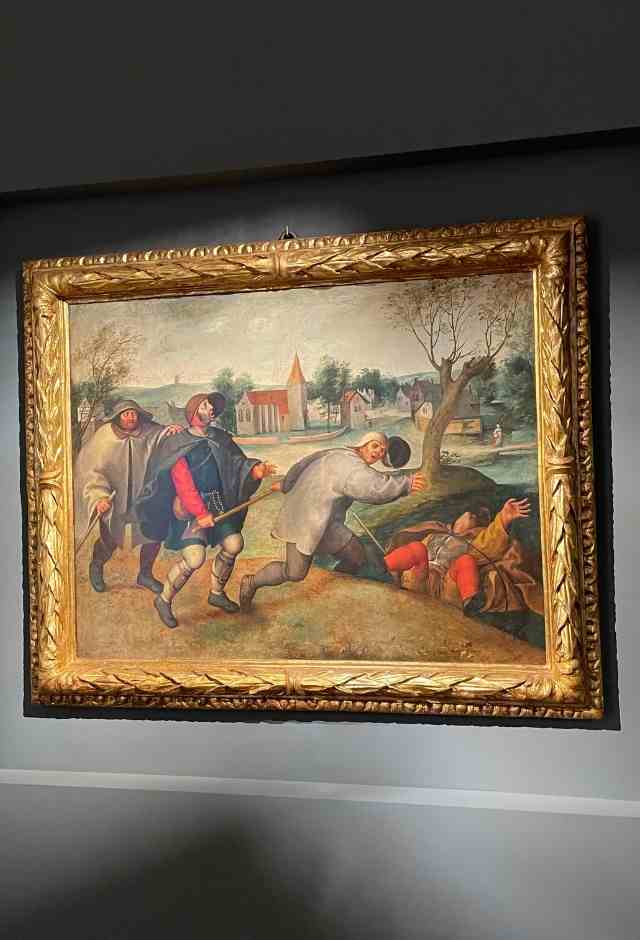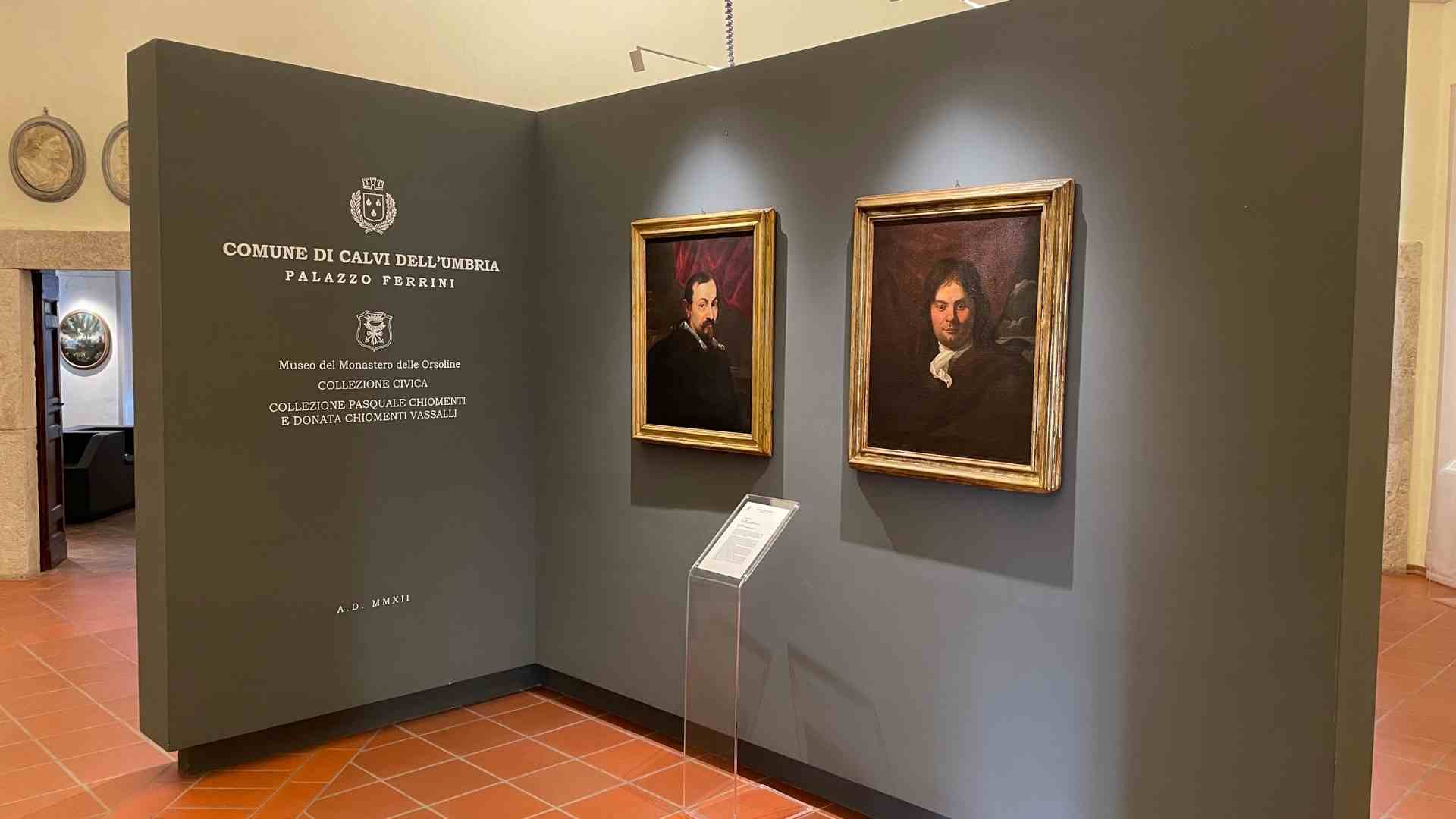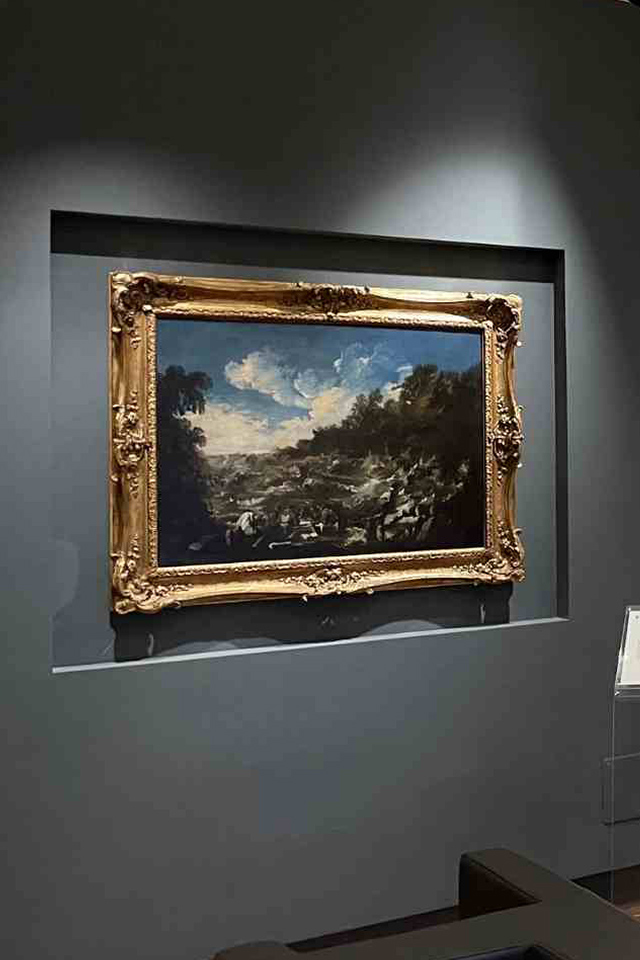punto di interesse
Museum of the Ursuline Monastery
Museo
0744 710158
Saturday: 3pm–6pm
Sunday: 11am–1pm / 3pm–6pm

punto di interesse
Saturday: 3pm–6pm
Sunday: 11am–1pm / 3pm–6pm
point of interest
Saturday: 3pm–6pm
Sunday: 11am–1pm / 3pm–6pm


The Museum of the Ursuline Monastery is placed inside of the wide complex of the monastery placed at the ground floor of Ferrini Palace, built in 1606, first core of the monastic building and now home also of the Municipality of Calvi dell’Umbria.
Established in 2001 with paintings , sacred furnitures and works from the territory and from the same monastery, was enriched , almost after 10 years , with the Collezione Pasquale Chiomenti e Donata Chiomenti Vassalli, collection donated to the municipality by Filippo and Carlo in memory of their parents.
Passed the principal door overlooked by the arms of coat of the Ferrini’s family, passed the ticket office , to welcome the guest in the first of the six rooms, there are the portraits of two important exponents of this family:
In the first room are hosts the wood works of the museum, the series of the popes and that of the draws and incisions of the Collection Chiomenti-Vassalli.
Between the portraits of the different popes stands out that one of Pope Clemente IX, work of Giovan Battista Gaulli called il Baciccio, a pupil and collaborator of Bernini.
The sculpture of the roman manierism is represented by two busts of popes of Bastiano Torrigiani and Lorenzo Ottoni.
One wall is occupied by the large and detailed View of Rome from the Gianicolo hill by Giuseppe Vasi, engraving of 1765. From the Flemish school of the sixteenth century is a Memento Mori (remember that you must die), on the theme of death and the maiden of the Circle of Jan Sanders goes Hemessen.
The second hall is dedicated to the works from the territory of Calvi dell’Umbria: belongs to the local collection a big canvas representing the Pentecost, from the Church of San Francesco and belonging to Camillo Angelucci , active between the 1540 and 1584.
Outstanding are the Immaculate Conception of Agostino Masucci, from the Chapel of the Cemetery and the Martyrdom of Sant’Andrea attributed to the circle of Gerolamo Troppa, once located in the homonymous chapel of the Church of Santa Maria Assunta.
In this hall stands a collection of ancient silver from the Churches of Calvi and, especially, the Portrait of Queen Christina of Sweden, work by Jacob Ferdinand Voet, painted around 1670 and where the painter portrays the queen as a Minerva. From the same Vouet is the delicate Portrait of Isabella Strozzi Costaguti.
Of Pietro Nelli, a portrait of a girl in a rich dressing room, looks at us with questioning air.
The fourth hall hosts the series of landscape and that one of the genre subjects of the Collection Chiomenti-Vassalli: a series of views of ruins and landscapes among which interesting the two canvas of the XVII century of Pietro Montanini, called Petruccio Perugino represented a Mountain landscape with strong wind and peasants and a landscape with strong wind and stubborn mule conceived in parallel.
The most important work of the hall is Monks in a boat pulled ashore by Alessandro Magnasco called Il LIssandrino, painted after 1730.
The most important hall has five memorable works of the Collection Chiomenti Vassalli:
The last hall of the museum hosts the series of the sacred subjects , in addition two Still life with carpets by Francesco Noletti, known as Il Maletese.
The most significant work of the hall is the Condemnation of Giansenism in Rome in 1641 , work by Andrea Sacchi and Jan Miel , where is represent the reunion made in August 1, 1641, in the convent of Dominican of Santa Maria above Minerva for the sentence from the Inquisition of the Treatise of Augustinus, on the divine grace, written by the theologian Cornelius Jansenius and printed in Lovanio in 1640.

The Museum of the Ursuline Monastery is placed inside of the wide complex of the monastery placed at the ground floor of Ferrini Palace, built in 1606, first core of the monastic building and now home also of the Municipality of Calvi dell’Umbria.
Established in 2001 with paintings , sacred furnitures and works from the territory and from the same monastery, was enriched , almost after 10 years , with the Collezione Pasquale Chiomenti e Donata Chiomenti Vassalli, collection donated to the municipality by Filippo and Carlo in memory of their parents.
Passed the principal door overlooked by the arms of coat of the Ferrini’s family, passed the ticket office , to welcome the guest in the first of the six rooms, there are the portraits of two important exponents of this family:
In the first room are hosts the wood works of the museum, the series of the popes and that of the draws and incisions of the Collection Chiomenti-Vassalli.
Between the portraits of the different popes stands out that one of Pope Clemente IX, work of Giovan Battista Gaulli called il Baciccio, a pupil and collaborator of Bernini.
The sculpture of the roman manierism is represented by two busts of popes of Bastiano Torrigiani and Lorenzo Ottoni.
One wall is occupied by the large and detailed View of Rome from the Gianicolo hill by Giuseppe Vasi, engraving of 1765. From the Flemish school of the sixteenth century is a Memento Mori (remember that you must die), on the theme of death and the maiden of the Circle of Jan Sanders goes Hemessen.
The second hall is dedicated to the works from the territory of Calvi dell’Umbria: belongs to the local collection a big canvas representing the Pentecost, from the Church of San Francesco and belonging to Camillo Angelucci , active between the 1540 and 1584.
Outstanding are the Immaculate Conception of Agostino Masucci, from the Chapel of the Cemetery and the Martyrdom of Sant’Andrea attributed to the circle of Gerolamo Troppa, once located in the homonymous chapel of the Church of Santa Maria Assunta.
In this hall stands a collection of ancient silver from the Churches of Calvi and, especially, the Portrait of Queen Christina of Sweden, work by Jacob Ferdinand Voet, painted around 1670 and where the painter portrays the queen as a Minerva. From the same Vouet is the delicate Portrait of Isabella Strozzi Costaguti.
Of Pietro Nelli, a portrait of a girl in a rich dressing room, looks at us with questioning air.
The fourth hall hosts the series of landscape and that one of the genre subjects of the Collection Chiomenti-Vassalli: a series of views of ruins and landscapes among which interesting the two canvas of the XVII century of Pietro Montanini, called Petruccio Perugino represented a Mountain landscape with strong wind and peasants and a landscape with strong wind and stubborn mule conceived in parallel.
The most important work of the hall is Monks in a boat pulled ashore by Alessandro Magnasco called Il LIssandrino, painted after 1730.
The most important hall has five memorable works of the Collection Chiomenti Vassalli:
The last hall of the museum hosts the series of the sacred subjects , in addition two Still life with carpets by Francesco Noletti, known as Il Maletese.
The most significant work of the hall is the Condemnation of Giansenism in Rome in 1641 , work by Andrea Sacchi and Jan Miel , where is represent the reunion made in August 1, 1641, in the convent of Dominican of Santa Maria above Minerva for the sentence from the Inquisition of the Treatise of Augustinus, on the divine grace, written by the theologian Cornelius Jansenius and printed in Lovanio in 1640.

The Museum of the Ursuline Monastery , in addition to the Art Gallery, includes in its tour even the Historical Kitchen from the first half of the XVIII century and the Monumental crib in earthenware of the XVI century kept in the Oratory of Sant’Antonio Abate, placed nearby to the Church of Santa Brigida.

The Museum of the Ursuline Monastery , in addition to the Art Gallery, includes in its tour even the Historical Kitchen from the first half of the XVIII century and the Monumental crib in earthenware of the XVI century kept in the Oratory of Sant’Antonio Abate, placed nearby to the Church of Santa Brigida.

Ferdinando Fuga designed the complex of the Monastery of the Ursuline made between 1739 and 1743.
It was planned with four wings around a large square courtyard, but only one side was built.
The distribution system is simple and functional to the cloistered needs: a basement floor dedicated to services and kitchens, a ground floor, a first floor with the sequence of individual cells.
Particular suggestive is the tour to the kitchen, where are placed a cistern, a laundry, a bakery , rooms to the conservation of the food and the kitchens which shows the details of the routine of the community.
At the opposite side of the church there is the large monastic garden locked up by a high wall , an evocative place that has been waiting for years for a restoration adequate to its historical uniqueness.
Continue the tour:
Discover the Monumental Crib in the Oratory of Sant’Antonio Abate
Or continue the itinerary in the old town of Calvi:
Reach Piazza Mazzini
Or discover the points of interest of Calvi and of its territory:
discover all the points of interest of the village
Information, appointments and travel proposals on:
The Progressive Web App is part of the project “Le Terre dei Borghi Verdi”, realized in collaboration and with the contribution of Regione Umbria – Assessorato al Turismo
©2021 Le Terre dei Borghi Verdi
Le Terre dei Borghi Verdi
Welcome in Southern Umbria,
where the slowness becomes value
Information, appointments and travel proposals on:
The Progressive Web App is part of the project “Le Terre dei Borghi Verdi”, realized in collaboration and with the contribution of Regione Umbria – Assessorato al Turismo
©2021 Le Terre dei Borghi Verdi